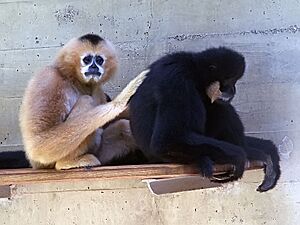Southern white-cheeked gibbon facts for kids
Quick facts for kids Southern white-cheeked gibbon |
|
|---|---|
 |
|
| Female (left) and male | |
| Conservation status | |
| Scientific classification | |
| Genus: |
Nomascus
|
| Species: |
siki
|
 |
|
| Southern white-cheeked gibbon range | |
The southern white-cheeked gibbon (Nomascus siki) is a type of gibbon, which is a small ape. These gibbons live in the forests of Vietnam and Laos. They are very similar to the northern white-cheeked gibbon (Nomascus leucogenys) and the yellow-cheeked gibbon (Nomascus gabriellae). For a long time, scientists thought they might be a subspecies of these other gibbons.
Contents
What Do Southern White-Cheeked Gibbons Look Like?
These gibbons change color as they grow!
- Baby gibbons are a light brown color.
- After they stop drinking milk from their mothers, they turn black.
- Adult males stay black.
- Adult females, however, turn brown.
The gibbon's name comes from the male's face. Males have a big patch of white fur around their mouths. This helps tell them apart from the northern white-cheeked gibbon, which has a white stripe on its cheeks. Female southern white-cheeked gibbons have a thin white outline around their faces.
Where Do Southern White-Cheeked Gibbons Live?
Southern white-cheeked gibbons live in lowland forests with many different types of trees. Some groups also live in forested mountain areas. Like all gibbons, they are arboreal, which means they spend almost all their time living in trees. They are also frugivorous, meaning they mostly eat fruit.
These gibbons used to live across a large area of central Vietnam and central Laos. Their territory stretched from the Nam Theun and Rao Nay rivers in the north to the Banghiang and Thach Han rivers in the south. In some northern areas, their territory might overlap with the northern white-cheeked gibbon.
Why Are Southern White-Cheeked Gibbons Endangered?
Even though they are still common in some large forests in Laos, their numbers are much lower in Vietnam. This is because people are cutting down their forest homes for logging and farming. Scientists believe their population has dropped by half in the last 45 years.
Because of this, the southern white-cheeked gibbon is now considered an endangered species. They are legally protected in Vietnam, but these laws are not always followed outside of special protected areas. A big threat to these gibbons in both Laos and Vietnam is hunting. They are hunted for food, for use in traditional medicine, and to be sold as pets.
How Scientists Study Southern White-Cheeked Gibbons
Scientists first officially described this gibbon in 1951. For many years, they debated whether it was its own species or a subspecies of other gibbons like the black crested gibbon, northern white-cheeked gibbon, or yellow-cheeked gibbon.
At one point, scientists thought it was a subspecies of the yellow-cheeked gibbon. Later, they thought it was a subspecies of the northern white-cheeked gibbon because their songs sounded similar and the females looked alike. However, since 2001, most scientists agree that the southern white-cheeked gibbon is its own unique species.
In the northern part of their range, southern white-cheeked gibbons sometimes live near northern white-cheeked gibbons. Some scientists still think they might be very closely related, possibly even subspecies of each other. In 2010, a group of gibbons that used to be considered southern white-cheeked gibbons were identified as a completely new species called the northern buffed-cheeked gibbon (N. annamensis).


